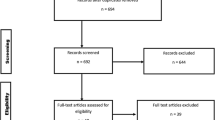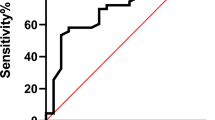Abstract
Objective
According to the current American College of Chest Physicians (ACCP) guideline, a cardiopulmonary exercise test (CPET) is indicated in patients with lung cancer being considered for lung surgery. The measurement of maximum oxygen consumption (\(\mathop V\limits^{ \cdot } O_{2}\) max) is not sufficiently prevalent because it requires special technical equipment. Considering that stepping is a simple and common exercise, we aimed to establish a simple and reproducible test with standardization of exercise intensity using a triaxial accelerometer.
Methods
Twenty healthy volunteers (10 male, 10 female) were included in the study. The subjects were obliged to step on the same spot at the rate of 80 and 110 counts for 1 min each and then step as quickly as possible for the last minute. Oxygen consumption (\(\mathop V\limits^{ \cdot } O_{2}\)) (mL/kg/min) for every breath was continuously measured during the exercise. A triaxial accelerometer was attached to the hip of test subjects whereby metabolic equivalents (METs) at each test level were measured.
Results
The mean age of the study subjects was 42.9 ± 11.4 (mean ± SD). The mean value of \(\mathop V\limits^{ \cdot } O_{2}\) at each level increased linearly along with the stepping level in each individual but varied among subjects. Using METs instead of step counts minimized the difference in regression lines among subjects. A receiver operating characteristic analysis revealed the possibility of \(\mathop V\limits^{ \cdot } O_{2}\) prediction for the critical values of 10 and 20 mL/kg/min using METs.
Conclusion
A simple and reproducible stepping test was suggested as applicable to standardizing the intensity of exercise using a triaxial accelerometer.





Similar content being viewed by others
References
Brunelli A, Kim AW, Berger KI, Addrizzo-Harris DJ. Physiologic evaluation of the patient with lung cancer being considered for resectional surgery: diagnosis and management of lung cancer, 3rd ed: American college of chest physicians evidence-based clinical practice guidelines. Chest. 2013;143(Suppl):e166S – e190.
British Thoracic Society. Society of Cardiothoracic Surgeons of Great Britain and Ireland Working Party. BTS guidelines: guidelines on the selection of patients with lung cancer for surgery. Thorax. 2001;56:89–108.
Sawabata N, Nagayasu T, Kadota Y, Goto T, Horio H, Mori T, et al. Risk assessment of lung resection for lung cancer according to pulmonary function: republication of systematic review and proposals by guideline committee of the Japanese Association for Chest Surgery 2014. Gen Thorac Cardiovasc Surg. 2015;63:14–21.
Nakagawa T, Chiba N, Saito M, Sakaguchi Y, Ishikawa S. Clinical relevance of decreased oxygen saturation during 6-min walk test in preoperative physiologic assessment for lung cancer surgery. Gen Thorac Cardiovasc Surg. 2014;62:620–6.
Nakagawa T, Tomioka Y, Toyazaki T, Gotoh M. Association between values of preoperative 6-min walk test and surgical outcomes in lung cancer patients with decreased predicted postoperative pulmonary function. Gen Thorac Cardiovasc Surg. 2018;66:220–4.
Brunelli A, Charloux A, Bolliger CT, Rocco G, Sculier JP, Varela G, et al. ERS/ESTS clinical guidelines on fitness for radical therapy in lung cancer patients (surgery and chemo-radiotherapy). Eur Respir J. 2009;34:17–41.
Benzo RP, Sciurba FC. Oxygen consumption, shuttle walking test and the evaluation of lung resection. Respiration. 2010;80:19–23.
Wijeysundera DN, Pearse RM, Shulman MA, Abbott TEF, Torres E, Ambosta A, et al. Assessment of functional capacity before major non-cardiac surgery: an international, prospective cohort study METS study investigators. Lancet. 2018;391:2631–40.
Henriksen A, Johansson J, Hartvigsen G, Grimsgaard S, Hopstock L. Meas Phy Act Using Triaxial Wrist Worn Polar Act Trackers: a Syst Rev Int J Exerc Sci. 2020;13:438–54.
Shioya T, Sato S, Iwakura M, Takahashi H, Terui Y, Uemura S, et al. Improvement of physical activity in chronic obstructive pulmonary disease by pulmonary rehabilitation and pharmacological treatment. Res Investig. 2018;56:292–306.
Oshima Y, Kawaguchi K, Tanaka S, Ohkawara K, Hikihara Y, Ishikawa-Takata K, et al. Class Househ Locomot Act Using Triaxial Accel Gait Posture. 2010;3:370–4.
Ohkawara K, Oshima Y, Hikihara Y, Ishikawa-Takata K, Tabata I, Tanaka S. Real-time estimation of daily physical activity intensity by a triaxial accelerometer and a gravity-removal classification algorithm. Br J Nutr. 2011;105:1681–91.
Jones NL, Campbell EJ. Clinical exercise testing. Philadelphia: Saunders; 1982. p. 202.
Acknowledgements
We thank all volunteers who participated in the study as the subjects. We also give special thanks to Jitsumi Kitagawa, Ayano Kobayashi, and Haruki Kawabe at the Department of Physiological Examination Laboratory for helping with the process of measuring \(\mathop V\limits^{ \cdot } O_{2}\) We thank Hugh McGonigle, from Edanz (https://jp.edanz.com/ac) for editing a draft of the manuscript.
Author information
Authors and Affiliations
Corresponding author
Ethics declarations
Conflict of interest
None declared.
Additional information
Publisher's Note
Springer Nature remains neutral with regard to jurisdictional claims in published maps and institutional affiliations.
Supplementary Information
Below is the link to the electronic supplementary material.
11748_2022_1860_MOESM1_ESM.pptx
Supplemental Fig. E1 Comparison of the METs-VO2 plot regression lines between the preliminary and present experiments. In the preliminary, all steps were paced with an electronic metronome and were increased by 15 counts every minute from 75 to 135. There was no significant difference between two lines in 10 of 11 cases. Black circles represent the present data and red squares represent the preliminary data (PPTX 89 KB)
Rights and permissions
Springer Nature or its licensor holds exclusive rights to this article under a publishing agreement with the author(s) or other rightsholder(s); author self-archiving of the accepted manuscript version of this article is solely governed by the terms of such publishing agreement and applicable law.
About this article
Cite this article
Nakagawa, T., Fukui, T., Ohsumi, Y. et al. Association between oxygen consumption and stepping exercise standardized with a triaxial accelerometer. Gen Thorac Cardiovasc Surg 71, 27–32 (2023). https://doi.org/10.1007/s11748-022-01860-0
Received:
Accepted:
Published:
Issue Date:
DOI: https://doi.org/10.1007/s11748-022-01860-0




